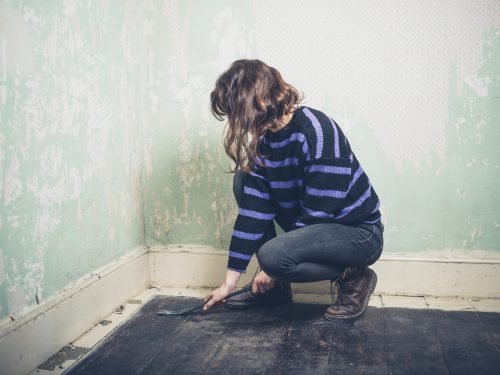Remodel 8 Things to Consider
The first thing to understand is there’s no such thing as one-size-fits-all design for aging in place.
-Louis Tenenbaum CAPS,The Nation’s Leading Authority on Aging in Place
8 Things to Consider Before Remodeling to Age in Place
Aging in place is almost universally accepted as a good idea because the benefits are so clear: the freedom and dignity that come from staying in your own home, the ability to make your own decisions, the maintenance of friendships and community ties.
According to new data coming out of USC, the desire to move after age 55 basically flat-lined, having peaked in the early 20s. The good news is, there’s a whole industry dedicated to helping people modify their homes. But doing so can be a stressful and expensive endeavor. That’s why you need to understand the details of home modifications – and the impact – before you get started.
There’s plenty of “conventional wisdom” that passes for good advice these days, but it can be hard to separate the helpful from the hype. Blindly following trends can be worse than a waste of money. Some things are simply not good investments, while others are dead wrong for you and your situation.
8 Things to Consider Before Remodeling to Age in Place
One-floor design vs. elevator Most so-called experts will tell you that living on one floor is unequivocally the best way to go. But that’s not always the case. Many single-floor houses have long hallways. If strength or stamina is an issue or if walking is difficult, an elevator might make more sense.
Installing one that connects the area where you spend a lot of time on one floor to important spaces on another can significantly reduce time on your feet. Another advantage is that you can also roll a full cart into an elevator, so you don’t have to carry bags, packages, laundry, etc.
But the elevator location is a tricky design problem. For one thing, the shaft takes up space on all floors. Then you must build in extra maneuvering space to enter and exit on foot, with a walker or in a wheelchair. On top of that, the cost of construction and installation can be prohibitive: from $30,000 to $65,000 – plus ongoing maintenance costs.
Placing the shaft outside the house walls is even more expensive because you must excavate, install footings, break through to the interior and finish the new exterior, in addition to heating and cooling the new space.
No-step entry It’s definitely a good idea to have at least one of these. But there’s a host of related issues that go beyond the construction work. Outside, you’ll probably want a covered entry to protect you from the elements. And you need good drainage since the doorway will be level with the walking surface just outside the door. Once inside, you’ll need space for maneuvering.
If it’s too complicated or expensive to create a no-step entry at an existing doorway, think outside the box. Could you turn a window into a doorway to enter a larger area or turn a small or underused room into a new foyer? A fringe benefit could be making the living room less of a hallway.
Widened doors Expanding the width of doorways is useful to accommodate wheelchairs and walkers as well as people with any kind of mobility issues. Wider doors allow two people to cross at the same time. But altering doorways can be difficult. Challenges include carrying the structural load from floors and roofs above and rerouting wires or mechanical systems that are located in the walls next to the door. You also need a plan for patching the floor space where the walls used to be.
Pocket doors While these space-savers do create more maneuvering room, they present a challenge that most people don’t anticipate. First, creating the pocket requires exposing enough wall area for two-door widths. Second, as generally installed, pocket doors can only accommodate flat handles, which are difficult to grasp, even by people with full manual dexterity. To make space for a regular door handle, you will need to install a wider door in a wider opening, so the fully open door sits outside the pocket and allows a more easily grasped handle.
Stair glide This is one of the most common pieces of aging-in-place equipment, but it has some drawbacks. The most basic chairlift (the kind that runs straight up and down) costs about $3,000, installed. But custom units for stairs that have turns and landings can run as high as $12,000. While glides can be a godsend for people with heart conditions or bad knees, they are not ideal for people with bad hips or who have difficulty sitting or balancing in a seated position.
Another issue: People who use a walker or wheelchair will need one on each floor. They’ll also need help getting into and out of the glide at all transfer points. Furthermore, there must be maneuvering space for you and your assistive devices on both floors. I have seen a lot of homes with idle stair glides because they didn’t help in the way owners expected them to.
Walk-in Tubs Some of the biggest confusion about aging in place centers on bathroom choices. One example is the hugely popular walk-in tub, which at first might seem like a brilliant idea.
A tub with a door sounds like it would be much easier and safer to access than a conventional tub. Unfortunately, what people fail to realize is that with most walk-in tubs, you have to maneuver very carefully through a narrow door and then get out of the way as the door swings shut. And you still must climb over a low step. So, if you’re walking or flexibility is compromised, this unit won’t be effective.
Think about how you take a bath: You generally fill the tub with water before you climb in. But with a walk-in, you enter first and close the door – when you sit there waiting for the water to fill. When you’re done, you must drain out all the water before you can reopen the door to exit. Manufacturers recognize the issue because they list speedy drain times in their advertising. But not everyone is comfortable with this arrangement.
Beyond that, walk-in tubs are pricey – around $10,000 installed – so consider the difficulties and limitations before you shell out the money. The best solution is a curbless shower, with no hurdles to overcome when entering or exiting.
Built-in shower seats These are an increasingly common feature yet are often not utilized the way they were intended because most seats are placed too far from the showerhead and controls. As a result, most are typically used to prop up your foot while shaving your legs or as a big shelf. A movable seat is a better (and less expensive) solution. You can adjust the placement to your needs or remove it to maximize maneuvering space. To optimize a seat, you also need a handheld shower handle that you move instead of moving yourself back and forth. This should be mounted on an adjustable grab bar, not mounted on a slide bar that won’t support you.
Glass shower doors Many people think glass shower or tub doors are an upgrade, but sliding doors block half the opening, making entry/exit more challenging. It also makes helping a seated bather a near impossibility. Swinging doors block your reach to a solid (i.e., mounted) grip on the wall. Your best bet: a good old-fashioned $20 shower curtain.
~Louis Tenenbaum (2016 Top 50 Aging Influencer)
Louis was a member of the original CAPS strategy sessions at the National Endowment for the Arts. Louis has been a course developer expert for the original and revised CAPS course and a member of the CAPS board of governors at the program’s inception.
~Louis Tenenbaum (2016 AARP Top 50 Aging Influencer)
Louis was a member of the original CAPS strategy sessions at the National Endowment for the Arts. Louis has been a course developer expert for the original and revised CAPS course and a member of the CAPS board of governors at the program’s inception.
See:homesrenewed.org
________________________________________________________________________________________________
Measure twice; cut one.
~Alistair MacLeod


